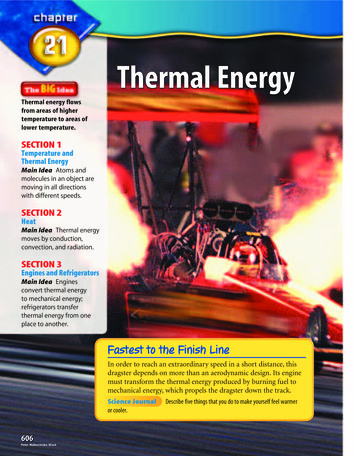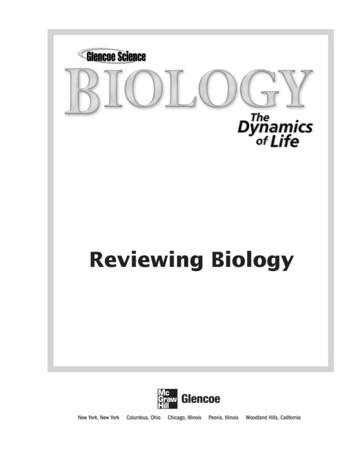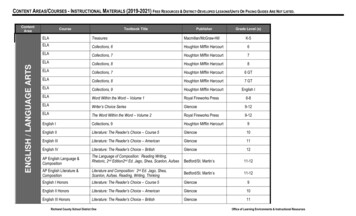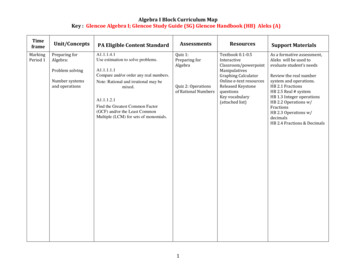
Transcription
Thermal EnergyThermal energy flowsfrom areas of highertemperature to areas oflower temperature.SECTION 1Temperature andThermal EnergyMain Idea Atoms andmolecules in an object aremoving in all directionswith different speeds.SECTION 2HeatMain Idea Thermal energymoves by conduction,convection, and radiation.SECTION 3Engines and RefrigeratorsMain Idea Enginesconvert thermal energyto mechanical energy;refrigerators transferthermal energy from oneplace to another.Fastest to the Finish LineIn order to reach an extraordinary speed in a short distance, thisdragster depends on more than an aerodynamic design. Its enginemust transform the thermal energy produced by burning fuel tomechanical energy, which propels the dragster down the track.Science Journalor cooler.606Peter Walton/Index StockDescribe five things that you do to make yourself feel warmer
Start-Up ActivitiesMeasuring TemperatureWhen you leave a glass of ice water on akitchen table, the ice gradually melts andthe temperature of the water increases.What is temperature, and why does thetemperature of the ice water increase?In this lab you will explore one way of determining temperature.1. Obtain three pans. Fill one pan with lukewarm water. Fill a second pan with coldwater and crushed ice. Fill a third pan withvery warm tap water. Label each pan.2. Soak one of your hands in the warm waterfor one minute. Remove your hand fromthe warm water and put it in the lukewarm water. Does the lukewarm waterfeel cool or warm?3. Now soak your hand in the cold water forone minute. Remove your hand from thecold water and place it in the lukewarmwater. Does the lukewarm water feel coolor warm?4. Think Critically Write a paragraph inyour Science Journal discussing whetheryour sense of touch would make a usefulthermometer.Thermal Energy Make thefollowing Foldable to help youidentify how thermal energy,heat, and temperature arerelated.STEP 1 Fold a vertical piece of paper intothirds.STEP 2 Turn the paper horizontally. Unfoldand label the three columns asshown.TemperatureThermalEnergyHeatRead for Main Ideas Before you read thechapter, write down what you know about temperature, thermal energy, and heat on theappropriate tab. As you read, add to and correctwhat you wrote. Write what you have learnedabout the relationship between heat and thermal energy on the back of your Foldable.Preview this chapter’s contentand activities atblue.msscience.com607Peter Walton/Index Stock
Learn It!Main ideas are the most important ideas in aparagraph, a section, or a chapter. Supporting details are facts or examplesthat explain the main idea. Understanding the main idea allows you tograsp the whole picture.Picture It!Read the following paragraph. Draw a graphicorganizer like the one below to show the main idea and supporting details.When you heat a pot of water on a stove,thermal energy can be transferred through thewater by a process other than conduction andradiation. In a gas or liquid, atoms or moleculescan move much more easily than they can in asolid. As a result, these particles can travel fromone place to another, carrying their energy withthem. This transfer of thermal energy by themovement of atoms or molecules from one part ofa material to another is called convection.—from page 614Main IdeaSupportingDetailsSupportingDetailsApply It!SupportingDetailsPick a paragraphfrom another section of this chapter and diagram the main ideas as you did above.608 ACHAPTER 21 Thermal Energy
Use this to focus on the main ideas as you read the chapter.tenea is ofdiniain aThe mentence always.stsrifthenotph, butargarapBefore you read the chapter, respond to the statementsbelow on your worksheet or on a numbered sheet of paper. Write an A if you agree with the statement. Write a D if you disagree with the statement.After you read the chapter, look back to this page to see if you’vechanged your mind about any of the statements. If any of your answers changed, explain why. Change any false statements into true statements. Use your revised statements as a study guide.Before You ReadA or DStatementAfter You ReadA or D1 Temperature depends on the kinetic energy ofthe molecules in a material.2 Heat engines can convert energy from one formto another.3 Objects cannot have a temperature below zeroon the Celsius scale.4 In a refrigerator, the coolant gas gets cooler as itis compressed.Print out a worksheetof this page atblue.msscience.com5 A conductor is any material that easily transfersthermal energy.6 Energy is created by an engine.7 Thermal energy from the Sun reaches Earth byconduction through space.8 A car’s engine converts thermal energy tomechanical energy.9 Thermal energy always moves from colderobjects to warmer objects.608 B
Temperature andThermal EnergyWhat is temperature? Explain how temperature isrelated to kinetic energy.Describe three scales used formeasuring temperature.Define thermal energy.The movement of thermal energytoward or away from your bodydetermines whether you feel toocold, too hot, or just right.Review Vocabularykinetic energy: energy a movingobject has that increases as thespeed of the object increasesNew Vocabulary temperaturethermal energyImagine it’s a hot day and you jump into a swimming pool tocool off. When you first hit the water, you might think it feelscold. Perhaps someone else, who has been swimming for a fewminutes, thinks the water feels warm. When you swim in water,touch a hot pan, or swallow a cold drink, your sense of touch tellsyou whether something is hot or cold. However, the words cold,warm, and hot can mean different things to different people.Temperature How hot or cold something feels is related to itstemperature. To understand temperature, think of a glass ofwater sitting on a table. The water might seem perfectly still, butwater is made of molecules that are in constant, randommotion. Because these molecules are always moving, they haveenergy of motion, or kinetic energy.However, water molecules in random motion don’t all moveat the same speed. Some are moving faster and some are moving slower. Temperature is a measure of the average value of thekinetic energy of the molecules in random motion. The morekinetic energy the molecules have, the higher the temperature.Molecules have more kinetic energy when they are movingfaster. So the higher the temperature, the faster the moleculesare moving, as shown in Figure 1.Figure 1 The temperature of asubstance depends on how fast itsmolecules are moving. Water molecules are moving faster in the hotwater on the left than in the coldwater on the right.Hot water608John EvansCHAPTER 21 Thermal EnergyCold water
Thermal Expansion It wasn’t an earthquake thatcaused the sidewalk to buckle in Figure 2. Hot weathercaused the concrete to expand so much that it cracked,and the pieces squeezed each other upward. When thetemperature of an object is increased, its moleculesspeed up and tend to move farther apart. This causesthe object to expand. When the object is cooled, itsmolecules slow down and move closer together. Thiscauses the object to shrink, or contract.Almost all substances expand when they are heatedand contract when they are cooled. The amount ofexpansion or contraction depends on the type of material and the change in temperature. For example, liquids usually expand more than solids. Also, the greater thechange in temperature, the more an object expands or contracts.Why do materials expand when theirtemperatures increase?Figure 2 Most objects expandas their temperatures increase.Pieces of this concrete sidewalkforced each other upward when theconcrete expanded on a hot day.Measuring TemperatureThe temperature of an object depends on the average kineticenergy of all the molecules in an object. However, molecules areso small and objects contain so many of them, that it is impossible to measure the kinetic energy of all the individual molecules.A more practical way to measure temperature is to use athermometer. Thermometers usually use the expansion andcontraction of materials to measure temperature. One commontype of thermometer uses a glass tube containing a liquid. Whenthe temperature of the liquid increases, it expands so that theheight of the liquid in the tube depends on the temperature.Temperature Scales To be able to give a number for thetemperature, a thermometer has to have a temperature scale.Two common temperature scales are the Fahrenheit and Celsiusscales, shown in Figure 3.On the Fahrenheit scale, the freezing point of water is giventhe temperature 32 F and the boiling point 212 F. The spacebetween the boiling point and the freezing point is divided into180 equal degrees. The Fahrenheit scale is used mainly in theUnited States.On the Celsius temperature scale, the freezing point of wateris given the temperature 0 C and the boiling point is given thetemperature 100 C. Because there are only 100 Celsius degreesbetween the boiling and freezing point of water, Celsius degreesare bigger than Fahrenheit degrees.Freezingpointof water(32 F)Freezingpointof water(0 C)Figure 3 The Fahrenheit andCelsius scales are commonly usedtemperature scales.SECTION 1 Temperature and Thermal Energy609(t)Nancy P. Alexander/Visuals Unlimited, (b)Morton & White
Converting Fahrenheit and Celsius You can converttemperatures back and forth between the two temperaturescales by using the following equations.Temperature Conversion Equations5To convert temperature in F to C: C ( )( F 32)99To convert temperature in C to F: F ( )( C) 325For example, to convert 68 F to degrees Celsius, first subtract 32,multiply by 5, then divide by 9. The result is 20 C.The Kelvin Scale Another temperature scale that is sometimes used is the Kelvin scale. On this scale, 0 K is the lowesttemperature an object can have. This temperature is known asabsolute zero. The size of a degree on the Kelvin scale is the sameas on the Celsius scale. You can change from Celsius degrees toKelvin degrees by adding 273 to the Celsius temperature.K C 273Solving a Simple EquationCONVERTING TO CELSIUS On a hot summer day, a Fahrenheit thermometer shows the temperature to be 86 F. What is this temperature on the Celsius scale?SolutionThis is what you know:Fahrenheit temperature: F 86This is what you need to find:Celsius temperature: CThis is the procedure youneed to use:Substitute the Fahrenheit temperature into theequation that converts temperature in F to C.595959 C ( )( F 32) (86 32) (54) 30 CCheck the answer:Add 32 to your answer and multiply by 9/5. Theresult should be the given Fahrenheit temperature.1. A student’s body temperature is 98.6 F. What is this temperature on the Celsius scale?2. A temperature of 57 C was recorded in 1913 at Death Valley, California. What is thistemperature on the Fahrenheit scale?For more practice visitblue.msscience.com610CHAPTER 21 Thermal Energy
Thermal EnergyThe temperature of an object is related to the average kineticenergy of molecules in random motion. But molecules also havepotential energy. Potential energy is energy that the moleculeshave that can be converted into kinetic energy. The sum of thekinetic and potential energy of all the molecules in an object is thethermal energy of the object.The Potential Energy of Molecules When you hold a ballabove the ground, it has potential energy. When you drop theball, its potential energy is converted into kinetic energy as theball falls toward Earth. It is the attractive force of gravitybetween Earth and the ball that gives the ball potential energy.The molecules in a material also exert attractive forces oneach other. As a result, the molecules in a material have potential energy. As the molecules get closer together or farther apart,their potential energy changes.Increasing Thermal Energy Temperature and thermalenergy are different. Suppose you have two glasses filled with thesame amount of milk, and at the same temperature. If you pourboth glasses of milk into a pitcher, as shown in Figure 4, thetemperature of the milk won’t change. However, because thereare more molecules of milk in the pitcher than in either glass,the thermal energy of the milk in the pitcher is greater than thethermal energy of the milk in either glass.Figure 4 At the same temperature, the larger volume of milk inthe pitcher has more thermalenergy than the smaller volumesof milk in either glass.SummarySelf CheckTemperatureTemperature is related to the average kineticenergy of the molecules an object contains.Most materials expand when their temperatures increase.1. Explain the difference between temperature and thermal energy. How are they related?2. Determine which temperature is always larger—anobject’s Celsius temperature or its Kelvin temperature.3. Explain how kinetic energy and thermal energy arerelated.4. Describe how a thermometer uses the thermal expansion of a material to measure temperature. Measuring TemperatureOn the Celsius scale the freezing point ofwater is 0 C and the boiling point is 100 C.On the Fahrenheit scale the freezing point ofwater is 32 F and the boiling point is 212 F. Thermal EnergyThe thermal energy of an object is the sum ofthe kinetic and potential energy of all themolecules in an object. 5. Convert Temperatures A turkey cooking in an ovenwill be ready when the internal temperature reaches180 F. Convert this temperature to C and K.blue.msscience.com/self check quizSECTION 1 Temperature and Thermal Energy611Tom Stack & Assoc.
HeatHeat and Thermal EnergyTo keep you comfortable, the flowof thermal energy into and out ofyour house must be controlled.It’s the heat of the day. Heat the oven to 375 F. A heat wavehas hit the Midwest. You’ve often heard the word heat, but whatis it? Is it something you can see? Heat is the transfer of thermalenergy from one object to another when the objects are at different temperatures. The amount of thermal energy that istransferred when two objects are brought into contact dependson the difference in temperature between the objects.For example, no thermal energy is transferred when two potsof boiling water are touching, because the water in both pots isat the same temperature. However, thermal energy is transferredfrom the pot of hot water in Figure 5 that is touching a pot ofcold water. The hot water cools down and the cold water getshotter. Thermal energy continues to be transferred until bothobjects are the same temperature.Review VocabularyTransfer of Thermal Energy When thermal energy is trans- Explain the difference betweenthermal energy and heat.Describe three ways thermalenergy is transferred.Identify materials that are insulators or conductors.electromagnetic wave: a waveproduced by vibrating electriccharges that can travel in matterand empty spaceNew Vocabulary heat conductorconductionspecific heatradiation convection thermalpollutionFigure 5 Thermal energy istransferred only when two objectsare at different temperatures.Thermal energy always movesfrom the warmer object to thecooler object.612Doug MartinCHAPTER 21 Thermal Energyferred, it always moves from warmer to cooler objects. Thermalenergy never flows from a cooler object to a warmer object. Thewarmer object loses thermal energy and becomes cooler as thecooler object gains thermal energy and becomes warmer. Thisprocess of thermal energy transfer can occur in three ways—byconduction, radiation, or convection.
ConductionWhen you eat hot pizza, you experience conduction. As the hot pizza touchesyour mouth, thermal energy moves fromthe pizza to your mouth. This transfer ofthermal energy by direct contact is calledconduction. Conduction occurs when theparticles in a material collide with neighboring particles.Imagine holding an ice cube in yourhand, as in Figure 6. The faster-movingmolecules in your warm hand bumpagainst the slower-moving molecules inthe cold ice. In these collisions, energy ispassed from molecule to molecule.Thermal energy flows from your warmerhand to the colder ice, and the slow-moving molecules in the icemove faster. As a result, the ice becomes warmer and its temperature increases. Molecules in your hand move more slowly asthey lose thermal energy, and your hand becomes cooler.Conduction usually occurs most easily in solids and liquids,where atoms and molecules are close together. Then atoms andmolecules need to move only a short distance before they bumpinto one another. As a result, thermal energy is transferred morerapidly by conduction in solids and liquids than in gases.Figure 6 An ice cube in yourhand melts because of conduction.Why does conduction occur more easily in solidsand liquids than in gases?RadiationOn a clear day, you walk outside and feel the warmth of theSun. How does this transfer of thermal energy occur? Thermalenergy transfer does not occur by conduction because almost nomatter exists between the Sun and Earth. Instead, thermalenergy is transferred from the Sun to Earth by radiation.Thermal energy transfer by radiation occurs when energy istransferred by electromagnetic waves. These waves carry energythrough empty space, as well as through matter. The transfer ofthermal energy by radiation can occur in empty space, as well asin solids, liquids, and gases.The Sun is not the only source of radiation. All objects emitelectromagnetic radiation, although warm objects emit moreradiation than cool objects. The warmth you feel when you sitnext to a fireplace is due to the thermal energy transferred byradiation from the fire to your skin.SECTION 2 Heat613Matt Meadows
ConvectionComparing Ratesof MeltingProcedure1. Prepare ice water by fillinga glass with ice and thenadding water. Let the glasssit until all the ice melts.2. Place an ice cube in a coffee cup.3. Place a similar-sized icecube in another coffee cupand add ice water to adepth of about 1 cm.4. Time how long it takesboth ice cubes to melt.Analysis1. Which ice cube meltedfastest? Why?2. Is air or water a betterinsulator?Explain.When you heat a pot of water on a stove, thermal energy canbe transferred through the water by a process other than conduction and radiation. In a gas or liquid, atoms or molecules canmove much more easily than they can in a solid. As a result,these particles can travel from one place to another, carryingtheir energy along with them. This transfer of thermal energy bythe movement of atoms or molecules from one part of a material to another is called convection.Transferring Thermal Energy by Convection As a pot ofwater is heated, thermal energy is transferred by convection.First, thermal energy is transferred to the water molecules at thebottom of the pot from the stove. These water molecules movefaster as their thermal energy increases. The faster-moving molecules tend to be farther apart than the slower-moving moleculesin the cooler water above. This causes the warm water to be lessdense than the cooler water. As a result, the warm water rises andis replaced at the bottom of the pot by cooler water. The coolerwater is heated, rises, and the cycle is repeated until all the waterin the pan is at the same temperature.Natural Convection Natural convection occurs when awarmer, less dense fluid is pushed away by a cooler, denser fluid.For example, imagine the shore of a lake. During the day, thewater is cooler than the land. As shown in Figure 7, air above thewarm land is heated by conduction. When the air gets hotter, itsparticles move faster and get farther from each other, makingthe air less dense. The cooler, denser air from over the lake flowsin over the land, pushing the less dense air upward. You feel thismovement of incoming cool air as wind. The cooler air then isheated by the land and also begins to rise.Warm airFigure 7 Wind movement neara lake or ocean can result from natural convection.Cool air614CHAPTER 21 Thermal EnergyJeremy Hoare/PhotoDisc
Warm airFigure 8 This computer usesforced convection to keep the electronic components surrounded bycooler air.Identify another example of forcedconvection.Cool airObserving ConvectionProcedureForced Convection Sometimes convection can be forced.Forced convection occurs when an outside force pushes a fluid,such as air or water, to make it move and transfer thermal energy.A fan is one type of device that is used to move air. For example,computers use fans to keep their electronic components fromgetting too hot, which can damage them. The fan blows cool aironto the hot electronic components, as shown in Figure 8.Thermal energy from the electronic components is transferred tothe air around them by conduction. The warm air is pushed awayas cool air rushes in. The hot components then continue to losethermal energy as the fan blows cool air over them.Thermal ConductorsWhy are cooking pans usually made of metal? Why does thehandle of a metal spoon in a bowl of hot soup become warm?The answer to both questions is that metal is a good conductor.A conductor is any material that easily transfers thermal energy.Some materials are good conductors because of the types ofatoms or chemical compounds they contain.What is a conductor?Remember that an atom has a nucleus surrounded by one ormore electrons. Certain materials, such as metals, have someelectrons that are not held tightly by the nucleus and are freer tomove around. These loosely held electrons can bump into otheratoms and help transfer thermal energy. The best conductors ofthermal energy are metals such as gold and copper.1. Fill a 250-mL beaker withroom-temperature waterand let it stand undisturbed for at least 1 min.2. Using a hot plate, heat asmall amount of water in a50-mL beaker until it isalmost boiling.WARNING: Do not touchthe heated hot plate.3. Carefully place a pennyinto the hot water and letit stand for about 1 min.4. Take the penny out of thehot water with metaltongs and place it on atable. Immediately placethe 250-mL beaker on thepenny.5. Using a dropper, gentlyplace one drop of foodcoloring on the bottom ofthe 250-mL beaker ofwater.6. Observe what happens inthe beaker for severalminutes.AnalysisWhat happened when youplaced the food coloring in the250-mL beaker? Why?SECTION 2 Heat615Donnie Kamin/PhotoEdit, Inc.
Thermal InsulatorsAnimal InsulationTo survive in its arcticenvironment, a polar bearneeds good insulationagainst the cold.Underneath its fur, apolar bear has 10 cm ofinsulating blubber.Research how animals inpolar regions are able tokeep themselves warm.Summarize the differentways in your ScienceJournal.Figure 9 The insulation inhouses and buildings helps reducethe transfer of thermal energybetween the air inside and airoutside.If you’re cooking food, you want the pan to conduct thermalenergy easily from the stove to your food, but you do not wantthe handle of the pan to become hot. An insulator is a materialin which thermal energy doesn’t flow easily. Most pans have handles that are made from insulators. Liquids and gases are usuallybetter insulators than solids are. Air is a good insulator, andmany insulating materials contain air spaces that reduce thetransfer of thermal energy by conduction within the material.Materials that are good conductors, such as metals, are poorinsulators, and poor conductors are good insulators.Houses and buildings are made with insulating materials toreduce the flow of thermal energy between the inside and outside.Fluffy insulation like that shown in Figure 9 is put in the walls.Some windows have double layers of glass that sandwich a layerof air or other insulating gas. This reduces the outward flow ofthermal energy in the winter and the inward flow of thermalenergy in the summer.Heat AbsorptionOn a hot day, you can walk barefoot across the lawn, but theasphalt pavement of a street is too hot to walk on. Why is thepavement hotter than the grass? The change in temperature of anobject as it is heated depends on the material it is made of.Specific Heat The temperature changeof a material as it is heated depends on thespecific heat of the material. The specificheat of a material is the amount of thermalenergy needed to raise the temperature of1 kg of the material by 1 C.More thermal energy is needed tochange the temperature of a material with ahigh specific heat than one with a low specific heat. For example, sand on a beach hasa lower specific heat than water. During theday, radiation from the Sun warms the sandand the water. Because of its lower specificheat, the sand heats up faster than the water.At night, however, the sand feels cool andthe water feels warmer. The temperature ofthe water changes more slowly than thetemperature of the sand as they both losethermal energy to the cooler night air.616SuperStockCHAPTER 21 Thermal Energy
Thermal PollutionSome electric power plants and factoriesthat use water for cooling produce hotwater as a by-product. If this hot water is released into an ocean,lake, or river, it will raise the temperature of the water nearby.This increase in the temperature of a body of water caused byadding warmer water is called thermal pollution. Rainwaterthat is heated after it falls on warm roads or parking lots also cancause thermal pollution if it runs off into a river or lake.Effects of Thermal Pollution Increasing the water temperature causes fish and other aquatic organisms to use more oxygen. Because warmer water contains less dissolved oxygen thancooler water, some organisms can die due to a lack of oxygen.Also, in warmer water, many organisms become more sensitiveto chemical pollutants, parasites, and diseases.Reducing Thermal Pollution Thermal pollution can bereduced by cooling the warm water produced by factories,power plants, and runoff before it is released into a body ofwater. Cooling towers like the ones shown in Figure 10 are usedto cool the water used by some power plants and factories.Figure 10 This power plant usescooling towers to cool the warmwater produced by the powerplant.SummarySelf CheckHeat and Thermal EnergyHeat is the transfer of thermal energy due to atemperature difference.Thermal energy always moves from a highertemperature to a lower temperature.Conduction, Radiation, and ConvectionConduction is the transfer of thermal energywhen substances are in direct contact.Radiation is the transfer of thermal energy byelectromagnetic waves.Convection is the transfer of thermal energyby the movement of matter.Thermal Conductors and Specific HeatA thermal conductor is a material in whichthermal energy moves easily.The specific heat of a substance is the amountof thermal energy needed to raise the temperature of 1 kg of the substance by 1 C.1. Explain why materials such as plastic foam, feathers, andfur are poor conductors of thermal energy.2. Explain why the sand on a beach cools down at nightmore quickly than the ocean water.3. Infer If a substance can contain thermal energy, can asubstance also contain heat?4. Describe how thermal energy is transferred from oneplace to another by convection.5. Explain why a blanket keeps you warm.6. Think Critically In order to heat a room evenly, shouldheating vents be placed near the floor or near the ceiling of the room? Explain. 7. Design an Experiment to determine whether woodor iron is a better thermal conductor. Identify thedependent and independent variables in yourexperiment.blue.msscience.com/self check quizSECTION 2 Heat617Colin Raw/Stone/Getty Images
Heating Up and Cioling DownDo you remember how long it took for a cup ofhot chocolate to cool before you could take asip? The hotter the chocolate, the longer itseemed to take to cool.Real-World QuestionHow does the temperature of a liquid affecthow quickly it warms or cools?Goals Measure the temperature change of waterat different temperatures. Infer how the rate of heating or coolingdepends on the initial water temperature.Materialsthermometers (5)400-mL beakers (5)stopwatch*watch with second handhot plate*Alternate materialsSafety PrecautionsWARNING: Do not use mercury thermometers.Use caution when heating with a hot plate. Hotand cold glass appears the same.Procedure3. Record the water temperature at minute 0,and then every minute for 10 min.4. Repeat step 3 starting with hot tap water,cold tap water, refrigerated water, and icewater with the ice removed.Conclude and Apply1. Graph your data. Plot and label lines forall five beakers on one graph.2. Calculate the rate of heating or cooling forthe water in each beaker by subtracting theinitial temperature of the water from thefinal temperature and then dividing thisanswer by 10 min.3. Infer from your results how the differencebetween room temperature and the initialtemperature of the water affected the rateat which it heated up or cooled down.1. Make a data table to record the temperatureof water in five beakers every minute from0 to 10 min.2. Fill one beaker with 100 mL of water. Placethe beaker on a hot plate and bring thewater to a boil. Carefully remove the hotbeaker from the hot plate.618Aaron HauptCHAPTER 21 Thermal EnergyShare your data and graphs with otherclassmates and explain any differencesamong your data.
Engines andRefrigeratorsHeat EnginesThe engines used in cars, motorcycles, trucks, and othervehicles, like the one shown in Figure 11, are heat engines. Aheat engine is a device that converts thermal energy intomechanical energy. Mechanical energy is the sum of the kineticand potential energy of an object. The heat engine in a car converts thermal energy into mechanical energy when it makes thecar move faster, causing the car’s kinetic energy to increase. Describe what a heat enginedoes.Explain that energy can exist indifferent forms, but is never created or destroyed.Describe how an internal combustion engine works.Explain how refrigerators movethermal energy.Forms of Energy There are other forms of energy besides thermal energy and mechanical energy. For example, chemicalenergy is energy stored in the chemical bonds between atoms.Radiant energy is the energy carried by electromagnetic waves.Nuclear energy is ene
your Science Journal discussing whether your sense of touch would make a useful thermometer. Start-Up Activities Preview this chapter's content and activities at blue.msscience.com Thermal Energy Te mp ra ure He a t 607 Peter Walton/Index Stock










